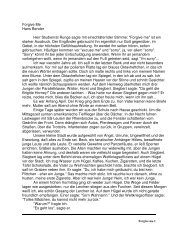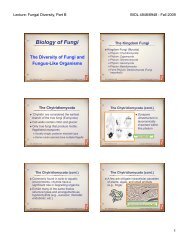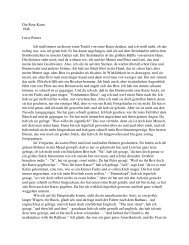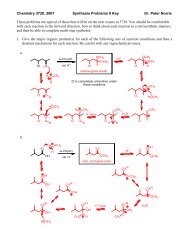Basic Principles of Polymer Chemistry - the Arts and Sciences page ...
Basic Principles of Polymer Chemistry - the Arts and Sciences page ...
Basic Principles of Polymer Chemistry - the Arts and Sciences page ...
You also want an ePaper? Increase the reach of your titles
YUMPU automatically turns print PDFs into web optimized ePapers that Google loves.
I <strong>Polymer</strong> Age<br />
<strong>Chemistry</strong> 5861 - <strong>Polymer</strong> <strong>Chemistry</strong> 1<br />
<strong>Basic</strong> <strong>Principles</strong> <strong>of</strong> <strong>Polymer</strong> <strong>Chemistry</strong> (Part I - Chapter 1 in Stevens) 1<br />
A) Classes <strong>of</strong> Molecules<br />
1)<br />
2)<br />
<strong>Polymer</strong> derives from Greek terms “<strong>Polymer</strong>” = “poly” + “mer”<br />
a)<br />
b)<br />
Molecular Weights <strong>of</strong> thous<strong>and</strong>s to millions<br />
Many thous<strong>and</strong>s <strong>of</strong> different molecules even in “pure” samples<br />
i)<br />
ii)<br />
iii)<br />
<br />
<br />
<br />
<br />
<br />
<br />
<br />
<br />
<br />
Samples are inhomogeneous<br />
Even closely related polymers samples vary by: ;<br />
molecular weights<br />
MW distribution<br />
degree <strong>and</strong> type <strong>of</strong> branching<br />
end group identity<br />
stereochemistry <strong>of</strong> side chains<br />
etc.<br />
Exact structures <strong>and</strong> structure distributions vary from sample to sample<br />
due to differences in:<br />
syn<strong>the</strong>tic route<br />
exact reaction conditions<br />
reagent purity, stoichiometry, etc.<br />
These properties are fundamentally different from “Discrete” molecules include<br />
organics, pharmaceuticals, organometallics, etc., which are typically characterized by:<br />
1 The graphics in <strong>the</strong>se notes indicated by “Figure/Table/Equation/Etc., x.x in Stevens” are taken from our lecture<br />
text: “<strong>Polymer</strong> <strong>Chemistry</strong>: An Introduction - 3 rd Edition” Malcolm P. Stevens (Oxford University Press, New York,<br />
©2002, Dr. Allen D. Hunter, Youngstown State University Department <strong>of</strong> <strong>Chemistry</strong>
1999).<br />
3)<br />
a)<br />
b)<br />
c)<br />
a)<br />
b)<br />
c)<br />
<strong>Chemistry</strong> 5861 - <strong>Polymer</strong> <strong>Chemistry</strong> 2<br />
Molecular Weights typically from a few dozen to a few thous<strong>and</strong><br />
Each molecule in a “pure” sample is identical (except for isotopomers)<br />
Sample structure independent <strong>of</strong> preparation route<br />
Extended Solids<br />
A very large network<br />
A bulk sample is essentially one molecule with 3-8 bonds between most adjacent<br />
atoms<br />
Most familiar examples to you are solid state materials such as diamond, metal<br />
oxides, <strong>and</strong> minerals<br />
B) Examples <strong>of</strong> Common <strong>Polymer</strong>s<br />
1)<br />
2)<br />
3)<br />
4)<br />
polymer syn<strong>the</strong>sis requires difunctional reagents<br />
“Source” Names are most widely used<br />
a)<br />
b)<br />
a)<br />
b)<br />
a)<br />
b)<br />
you should know all that we discuss in class, most are pretty self explanatory<br />
cf. IUPAC names, more later<br />
Vinyl <strong>Polymer</strong>s are made on largest industrial scale<br />
ethylene → polyethylene, PE<br />
vinyl chloride → poly(vinyl chloride), PVC<br />
<strong>Polymer</strong>s with <strong>the</strong> same idealized structures can have very different molecular weight<br />
distributions <strong>and</strong> properties when made from different routes<br />
ethylene oxide → poly(ethylene oxide), PEO<br />
ethylene glycol → poly(ethylene glycol), PEG<br />
©2002, Dr. Allen D. Hunter, Youngstown State University Department <strong>of</strong> <strong>Chemistry</strong>
5)<br />
a)<br />
b)<br />
<strong>Chemistry</strong> 5861 - <strong>Polymer</strong> <strong>Chemistry</strong> 3<br />
All monomers used to prepare a particular polymer can be <strong>the</strong> same or pairs <strong>of</strong><br />
matched monomers may be used<br />
ethylene glycol + terephthalic acid → poly(ethylene terephthalate). PET<br />
para-hydroxybenzoic acid → poly(para-hydroxybenzoic acid), PHB<br />
C) Stoichiometry <strong>of</strong> <strong>Polymer</strong>izations<br />
1)<br />
2)<br />
Addition <strong>Polymer</strong>ization<br />
a)<br />
b)<br />
a)<br />
b)<br />
Mass unchanged (most atom efficient wrt. “Green <strong>Chemistry</strong>”)<br />
Typically have higher MW <strong>and</strong> narrower MW distributions<br />
Condensation <strong>Polymer</strong>ization<br />
Mass <strong>of</strong> final polymer lower than mass to monomers<br />
Small molecules lost (most commonly H2O, HCl, etc.) during polymerization<br />
D) History <strong>of</strong> <strong>Polymer</strong> <strong>Chemistry</strong> as a Scientific Discipline<br />
1)<br />
2)<br />
3)<br />
4)<br />
Natural <strong>Polymer</strong>s have been mainstays <strong>of</strong> human technology since <strong>the</strong> dawn <strong>of</strong> time<br />
(e.g., lea<strong>the</strong>r, string/cloth, paper)<br />
Term “<strong>Polymer</strong>” 1 st used by Berzelius in 1833<br />
nitrated cellulose (almost always incorrectly called nitrocellulose)<br />
a)<br />
b)<br />
c)<br />
Made by HNO3 derivatization <strong>of</strong> a natural polymer<br />
Celluloid (film)<br />
Gun Cotton<br />
Styrene polymerization reported 1839 soon after styrene chemistry began but<br />
structure was not clear to authors<br />
©2002, Dr. Allen D. Hunter, Youngstown State University Department <strong>of</strong> <strong>Chemistry</strong>
5)<br />
6)<br />
7)<br />
a)<br />
b)<br />
c)<br />
d)<br />
<strong>Chemistry</strong> 5861 - <strong>Polymer</strong> <strong>Chemistry</strong> 4<br />
poly(ethylene glycol) reported in 1860s with correct structure<br />
phenol-formaldehyde resin made on commercial scale in early 1900’s by Leo<br />
Baekel<strong>and</strong> as “Bakelite” (this is still a very large scale material)<br />
WWII was a major spur to <strong>the</strong> polymer industry <strong>and</strong> supporting science<br />
Artificial rubber to replace natural Malaysian rubber<br />
Nylon to replace silk<br />
Syn<strong>the</strong>tic Fuels ⇒ monomeric staring materials<br />
Invested infrastructure costs<br />
E) Original ideas about Structures<br />
1)<br />
2)<br />
3)<br />
Were thought to be Colloids (aggregation or association <strong>the</strong>ory) ra<strong>the</strong>r than long<br />
chains since chains were thought to be unstable<br />
a)<br />
b)<br />
a)<br />
b)<br />
based on syn<strong>the</strong>tic experience in trying to build longer <strong>and</strong> longer chains<br />
based on early Entropy arguments<br />
Thermodynamic arguments by Hermann Staudinger (Nobel Prize in 1953) <strong>and</strong><br />
Wallace Caro<strong>the</strong>rs<br />
Quantified when would be stable<br />
i)<br />
ii)<br />
relatively low temperatures<br />
∆G = ∆H - T∆S<br />
Predicted solution <strong>and</strong> o<strong>the</strong>r properties (i.e., <strong>of</strong> “Ideal Solutions”)<br />
<strong>Polymer</strong>s were THE “test case” for emerging discipline <strong>of</strong> Thermodynamics (<strong>and</strong> also<br />
Kinetics) since so many <strong>of</strong> <strong>the</strong>ir properties were at odds with <strong>the</strong> intuitions <strong>of</strong><br />
chemists who usually studied discrete molecules<br />
©2002, Dr. Allen D. Hunter, Youngstown State University Department <strong>of</strong> <strong>Chemistry</strong>
II Definitions <strong>of</strong> Common <strong>Polymer</strong> Terms<br />
A) Molecular Size/Weight<br />
<strong>Chemistry</strong> 5861 - <strong>Polymer</strong> <strong>Chemistry</strong> 5<br />
1) Monomer ⇒ Oligomer ⇒ High Oligomer/Low MW <strong>Polymer</strong> ⇒ <strong>Polymer</strong><br />
B) <strong>Polymer</strong> Structure<br />
1)<br />
2)<br />
3)<br />
Repeating Unit<br />
a)<br />
b)<br />
a)<br />
b)<br />
Conventional Repeating unit depends on monomer used in syn<strong>the</strong>sis, e.g.<br />
i)<br />
ii)<br />
Polyethylene from Ethylene<br />
Polymethylene from Diazomethane<br />
The Base Unit is independent to syn<strong>the</strong>tic route <strong>and</strong> is smallest possible Repeating<br />
Unit<br />
End Groups<br />
Living <strong>Polymer</strong>s<br />
Telechelic <strong>Polymer</strong>s (reactive end groups)<br />
Reactive Oligomers<br />
C) Average Degree <strong>of</strong> <strong>Polymer</strong>ization = DP bar<br />
1)<br />
2)<br />
3)<br />
4)<br />
DP = Number <strong>of</strong> repeating units in chain (plus <strong>the</strong> number <strong>of</strong> end groups)<br />
DP bar = <strong>the</strong> Average number <strong>of</strong> repeating units in sample<br />
MW = DP x (Repeating Unit MW)<br />
CH3-(CH2)100-CH3 has a DP = 102<br />
©2002, Dr. Allen D. Hunter, Youngstown State University Department <strong>of</strong> <strong>Chemistry</strong>
D) Types <strong>of</strong> Atoms in <strong>Polymer</strong> Backbone<br />
1)<br />
2)<br />
Homochain <strong>Polymer</strong><br />
a)<br />
a)<br />
<strong>Chemistry</strong> 5861 - <strong>Polymer</strong> <strong>Chemistry</strong> 6<br />
e.g., vinyl polymers, polyacetylene, polysulfur, poly(dimethyl silane)<br />
Heterochain <strong>Polymer</strong>s<br />
e.g., polyesters, polye<strong>the</strong>rs, polyamides<br />
E) Order <strong>of</strong> repeating units in backbone<br />
1) Figure 1.1 in Stevens<br />
2)<br />
3)<br />
Homopolymer (cf. Homochain <strong>Polymer</strong>)<br />
a)<br />
a)<br />
b)<br />
made from a single monomer (or pair <strong>of</strong> monomers in cases like polyesters, etc.)<br />
Copolymer<br />
syn<strong>the</strong>sis<br />
i)<br />
ii)<br />
i)<br />
ii)<br />
iii)<br />
iv)<br />
made from more than one type <strong>of</strong> monomer<br />
or occasionally from more than one type <strong>of</strong> polymer<br />
Types <strong>of</strong> Copolymers<br />
R<strong>and</strong>om Copolymer<br />
Block Copolymer<br />
Alternating Copolymer<br />
Graft Copolymer<br />
F) Conventional <strong>Polymer</strong> Structure Types<br />
1)<br />
2)<br />
Figure 1.2 in Stevens<br />
Linear<br />
©2002, Dr. Allen D. Hunter, Youngstown State University Department <strong>of</strong> <strong>Chemistry</strong>
3)<br />
4)<br />
a)<br />
a)<br />
<strong>Chemistry</strong> 5861 - <strong>Polymer</strong> <strong>Chemistry</strong> 7<br />
this is an idealized structure that is very hard to produce in practice<br />
Branched<br />
b)<br />
a)<br />
b)<br />
may have only a few side chains or may be every few repeating units<br />
Equation 1.6 in Stevens<br />
Network (Crosslinked)<br />
Crosslink density related to “hardness”<br />
an average <strong>of</strong> more than two crosslinks per chain ⇒ infinite network<br />
G) Unconventional <strong>Polymer</strong> Structures<br />
1)<br />
2)<br />
Figure 1.3 in Stevens<br />
Branched<br />
a)<br />
b)<br />
c)<br />
Star<br />
i)<br />
ii)<br />
i)<br />
ii)<br />
iii)<br />
iv)<br />
i)<br />
ii)<br />
has a central core from which 3 or more arms branch<br />
note uses a viscosity modifiers in high performance engine oils<br />
Dendrimer (also known as Starburst or Cascade <strong>Polymer</strong>s)<br />
Comb<br />
generation numbers up to 5-7<br />
near spherical shapes<br />
note steric crowding gradient<br />
note uses for microencapsulation <strong>and</strong> drug delivery<br />
from Macromonomers such as 1-C20H40<br />
©2002, Dr. Allen D. Hunter, Youngstown State University Department <strong>of</strong> <strong>Chemistry</strong><br />
very high number <strong>of</strong> side chains, all <strong>of</strong> similar length
3)<br />
4)<br />
Network<br />
a)<br />
b)<br />
a)<br />
b)<br />
Ladder<br />
i)<br />
i)<br />
ii)<br />
<br />
<br />
<br />
<br />
cf. DNA<br />
Semiladder (Stepladder)<br />
Supramolecular<br />
<strong>Chemistry</strong> 5861 - <strong>Polymer</strong> <strong>Chemistry</strong> 8<br />
molecular superstructures held toge<strong>the</strong>r by non-covalent bonds<br />
examples<br />
H) Crosslinking<br />
1)<br />
2)<br />
3)<br />
a)<br />
b)<br />
Polyrotaxane<br />
nature <strong>of</strong> rotaxanes<br />
washers on a wire<br />
Polycatenane<br />
nature <strong>of</strong> catenanes<br />
chain links<br />
Degree <strong>of</strong> Crosslinking directly correlated with:<br />
hardness, elasticity, solvent induced swelling, etc.<br />
degree <strong>of</strong> swelling indicates degree <strong>of</strong> solvent-polymer compatibility <strong>and</strong> <strong>the</strong><br />
degree <strong>of</strong> crosslinking<br />
First “designed” crosslinking process is Vulcanization <strong>of</strong> rubber (Polyisoprene)<br />
Can be via covalent bonds, ionic interactions, or Van der Waals interactions (more<br />
later)<br />
©2002, Dr. Allen D. Hunter, Youngstown State University Department <strong>of</strong> <strong>Chemistry</strong>
III<br />
I) Thermoset <strong>Polymer</strong>s<br />
1)<br />
2)<br />
3)<br />
Example<br />
a)<br />
a)<br />
b)<br />
c)<br />
<strong>Chemistry</strong> 5861 - <strong>Polymer</strong> <strong>Chemistry</strong> 9<br />
phenol-formaldehyde resin (above)<br />
Properties<br />
Insoluble<br />
Non-melting<br />
Flexibility ⇒ Extended Solids<br />
Thermoset (e.g., Phenol-Formaldehyde) vs. Thermoplastic <strong>Polymer</strong> (e.g., PE)<br />
J) Classification by Use<br />
1)<br />
2)<br />
3)<br />
4)<br />
5)<br />
Plastics<br />
Fibers<br />
Rubbers (Elastomers)<br />
Coatings<br />
Adhesives<br />
<strong>Polymer</strong>ization Processes<br />
A) Classification <strong>of</strong> <strong>Polymer</strong> Reactions at Stoichiometric <strong>and</strong> Mechanistic Scales<br />
1)<br />
2)<br />
Reaction Stoichiometric Classification<br />
a)<br />
b)<br />
a)<br />
Addition vs. Condensation <strong>Polymer</strong>ization<br />
determined by loss <strong>of</strong> weight (or not) on polymerization<br />
Mechanistic Classification<br />
Step-Growth (Step-Reaction) vs. Chain-Growth (Chain-Reaction)<br />
©2002, Dr. Allen D. Hunter, Youngstown State University Department <strong>of</strong> <strong>Chemistry</strong>
3)<br />
b)<br />
a)<br />
b)<br />
B) Examples<br />
1)<br />
2)<br />
<strong>Chemistry</strong> 5861 - <strong>Polymer</strong> <strong>Chemistry</strong> 10<br />
need intimate reaction details to be certain<br />
Results <strong>of</strong> <strong>the</strong>se reaction types (i.e., net stoichiometry vs. reaction mechanism)<br />
a)<br />
b)<br />
c)<br />
a)<br />
b)<br />
c)<br />
On rate <strong>of</strong> polymerization<br />
On MW <strong>and</strong> MW distribution<br />
Most (but not all) Step Reaction <strong>Polymer</strong>izations are also Condensation Reactions<br />
Chose Examples from those we have had above, e.g.<br />
i)<br />
ii)<br />
iii)<br />
i)<br />
ii)<br />
i)<br />
ii)<br />
i)<br />
polyesters from dicarboxylic acids <strong>and</strong> diols<br />
polyamides from dicarboxylic acids <strong>and</strong> diamines<br />
polyamides from di(acid chlorides) <strong>and</strong> diamines<br />
In all <strong>of</strong> <strong>the</strong>se examples net atoms lost<br />
In all <strong>of</strong> <strong>the</strong>se reactions bond formation occurs one step at a time<br />
Many products can be made by ei<strong>the</strong>r Chain/Addition or Step/Condensation<br />
Polye<strong>the</strong>rs from epoxides vs. diols<br />
Chain/Addition Case: ethylene oxide → poly(ethylene oxide), PEO<br />
Step/Condensation Case: ethylene glycol → poly(ethylene glycol), PEG<br />
Polyesters from hydroxyacids vs. lactones<br />
acid)<br />
Chain/Addition Case: butyrolactone → Poly(butyrolactone)<br />
Step/Condensation Case: 4-hydroxybutyric acid → Poly(4-hydroxybutyric<br />
Nylons (Polyamides) from aminocarboxylic acids vs. lactams<br />
©2002, Dr. Allen D. Hunter, Youngstown State University Department <strong>of</strong> <strong>Chemistry</strong><br />
Chain/Addition Case: butyrolactam → Poly(butyrolactam)
3)<br />
a)<br />
b)<br />
c)<br />
ii)<br />
i)<br />
ii)<br />
i)<br />
i)<br />
ii)<br />
iii)<br />
i)<br />
ii)<br />
iii)<br />
acid)<br />
<strong>Chemistry</strong> 5861 - <strong>Polymer</strong> <strong>Chemistry</strong> 11<br />
Step/Condensation Case: 4-aminobutyric acid → Poly(4-aminobutyric<br />
Some materials can be made by ei<strong>the</strong>r Step/Addition or Chain/Condensation<br />
Polyurethanes from<br />
Normal - Step/Condensation Case: diamines + bischlor<strong>of</strong>ormates<br />
(ClC(O)O~R~OC(O)Cl) vs.<br />
Bizarre - Step/Addition Case: diisocyanates (OCN~R~NCO) + diols<br />
Polyureas from<br />
Bizarre - Step/Addition Case: diisocyanates (OCN~R~NCO) + diamines<br />
Polyhydrocarbons from<br />
Normal - Step/Condensation Case: reduction <strong>of</strong> alkane dihalides<br />
Normal - Chain/Addition Case: Olefin polymerization<br />
Bizarre - Chain/Condensation: Diazomethane reaction<br />
C) Property Differences Due to Syn<strong>the</strong>tic Route<br />
1)<br />
Much more detail later<br />
a)<br />
b)<br />
c)<br />
Tremendous variation from batch to batch, lab to lab, route to route<br />
Chemical properties generally similar due to similarities in types <strong>of</strong> “chemical<br />
structures”<br />
Physical properties markedly different due to differences in “polymer structures”<br />
MW & MW distribution<br />
Crosslinking type <strong>and</strong> density<br />
End group identity<br />
©2002, Dr. Allen D. Hunter, Youngstown State University Department <strong>of</strong> <strong>Chemistry</strong>
<strong>Chemistry</strong> 5861 - <strong>Polymer</strong> <strong>Chemistry</strong> 12<br />
d) Analytical properties depend on technique with some insensitive <strong>and</strong> some very<br />
sensitive to syn<strong>the</strong>tic route (i.e., IR & EA)<br />
D) Step Reaction <strong>Polymer</strong>ization<br />
1)<br />
2)<br />
Most commonly found with condensation reactions but <strong>the</strong>re are exceptions<br />
a)<br />
b)<br />
c)<br />
a)<br />
b)<br />
c)<br />
Bonds formed one at a times<br />
Most monomer used up quickly but get high MW only near end<br />
Wide MW distributions typical<br />
Work out <strong>the</strong> DP & DP bar for <strong>the</strong> following<br />
DP ≈ Number <strong>of</strong> repeating units in chain<br />
i)<br />
i)<br />
ii)<br />
i)<br />
ii)<br />
<br />
<br />
<br />
<br />
MW = DP x (Repeating Unit MW)<br />
DP bar = Average Number <strong>of</strong> repeating units in chain (plus <strong>the</strong> number <strong>of</strong> end<br />
groups)<br />
MW bar = DP bar x (Repeating Unit MW)<br />
DP bar = MW bar / Repeating Unit MW = <strong>the</strong> Average Number <strong>of</strong><br />
Repeating Units in Chain<br />
ρ = Reaction Conversion<br />
ρ = (No - N)/No where<br />
ρ is a measure <strong>of</strong> which fraction <strong>of</strong> <strong>the</strong> original monomers consumed<br />
No = number <strong>of</strong> molecules initially <strong>and</strong><br />
N = number <strong>of</strong> molecules finally<br />
DP bar = 1 / (1 - ρ)<br />
ρ = 0 at start when no polymerization<br />
©2002, Dr. Allen D. Hunter, Youngstown State University Department <strong>of</strong> <strong>Chemistry</strong>
iii)<br />
i)<br />
ii)<br />
iii)<br />
iv)<br />
i)<br />
<br />
<br />
<br />
<br />
<br />
<strong>Chemistry</strong> 5861 - <strong>Polymer</strong> <strong>Chemistry</strong> 13<br />
ρ ≈ 1 when polymerization complete (<strong>the</strong> numerical value <strong>of</strong> ρ gets closer<br />
to 1 at higher final MW)<br />
for 98% reaction conversion (i.e., ρ = 0.98) DP bar = 50<br />
To get high MW you need<br />
excellent reaction conversions (i.e., clean reactions that go to completion)<br />
very pure reagents (no mon<strong>of</strong>unctional species)<br />
very precise reaction stoichiometries<br />
d) Figure 1.4 in Stevens<br />
Step Reaction <strong>Polymer</strong>ization <strong>of</strong><br />
monomer A-B<br />
form<br />
E) Chain Reaction <strong>Polymer</strong>ization<br />
1)<br />
2)<br />
a)<br />
<br />
Show how polymerization effects array <strong>of</strong> A-B monomers<br />
Shows how even as ρ approaches 1, <strong>the</strong> average chain length stays low<br />
Only at very end when almost no low MW species present do long chains<br />
Most commonly found with addition reactions but <strong>the</strong>re are exceptions (e.g., <strong>the</strong><br />
Chain/Condensation polymerization <strong>of</strong> diazomethane)<br />
Generic Mechanisms<br />
Chain Initiation Step(s)<br />
generation <strong>of</strong> highly reactive species, e.g.<br />
free radical intermediate<br />
carbocation<br />
or carbanion<br />
©2002, Dr. Allen D. Hunter, Youngstown State University Department <strong>of</strong> <strong>Chemistry</strong>
3)<br />
4)<br />
5)<br />
6)<br />
b)<br />
c)<br />
d)<br />
a)<br />
a)<br />
b)<br />
<br />
<strong>Chemistry</strong> 5861 - <strong>Polymer</strong> <strong>Chemistry</strong> 14<br />
transition metal species<br />
Chain Propagation Step(s)<br />
i)<br />
i)<br />
i)<br />
2-3 step which increase MW <strong>of</strong> growing chain by adding monomers to end<br />
<strong>of</strong> growing chain<br />
Chain Termination Step(s)<br />
Consume <strong>the</strong> active species by recombination, etc.<br />
Chain Transfer Step(s)<br />
May be present <strong>and</strong> typically modify final polymer structure <strong>and</strong> MW<br />
Commonly found when have highly reactive intermediates<br />
Free Radicals, Carbocations, Carbanions, etc.<br />
Examples<br />
a)<br />
b)<br />
c)<br />
FR <strong>Polymer</strong>ization <strong>of</strong> Ethylene<br />
Nucleophilic <strong>Polymer</strong>ization <strong>of</strong> Ethylene Oxide (Ring Opening)<br />
Figure 1.5 in Stevens<br />
a)<br />
Chain Reaction <strong>Polymer</strong>ization <strong>of</strong><br />
monomer A-B<br />
Show how polymerization effects array <strong>of</strong> A-B monomers<br />
Even at low values <strong>of</strong> ρ (reaction conversion), some high MW chains are present<br />
Table 1.1 In Stevens<br />
Characteristics <strong>of</strong> Step <strong>and</strong> Chain<br />
Reactions, side by side comparisons<br />
©2002, Dr. Allen D. Hunter, Youngstown State University Department <strong>of</strong> <strong>Chemistry</strong>
IV<br />
<strong>Chemistry</strong> 5861 - <strong>Polymer</strong> <strong>Chemistry</strong> 15<br />
F) Step-Reaction/Addition & Chain-Reaction/Condensation - Bizarre Reaction<br />
Combinations<br />
1)<br />
2)<br />
Step-Reaction/Addition (described above)<br />
a)<br />
b)<br />
c)<br />
a)<br />
diisocyanates (OCN~R~NCO) + diols<br />
diisocyanates (OCN~R~NCO) + diamines<br />
Diels-Alder reaction <strong>of</strong> 1,6-bis(cyclopentadienyl)hexanes with benzoquinone<br />
Chain-Reaction/Condensation (described above)<br />
<strong>Polymer</strong>ization <strong>of</strong> CH2N2 initiated by BF3<br />
Nomenclature<br />
A) Vinyl Homopolymers), Homochain <strong>Polymer</strong>s<br />
1)<br />
2)<br />
Table 1.2 in Stevens<br />
Source Names depend on monomer (we will not<br />
typically use IUPAC names) for Vinyl Type<br />
<strong>Polymer</strong>s<br />
a)<br />
b)<br />
c)<br />
d)<br />
e)<br />
f)<br />
g)<br />
h)<br />
Ethylene → Polyethylene, PE<br />
(Methylene → Polymethylene)<br />
Propylene → Polypropylene, PP<br />
1-Hexene → Poly(1-hexene)<br />
1-Pentene → Poly(1-pentene)<br />
Isobutylene → Polyisobutylene<br />
Vinyl Chloride → Poly(vinyl chloride), PVC<br />
Vinylidene Dichloride → Poly(vinylidene dichloride)<br />
©2002, Dr. Allen D. Hunter, Youngstown State University Department <strong>of</strong> <strong>Chemistry</strong>
3)<br />
4)<br />
i)<br />
j)<br />
k)<br />
l)<br />
m)<br />
n)<br />
o)<br />
p)<br />
q)<br />
r)<br />
a)<br />
a)<br />
b)<br />
c)<br />
<strong>Chemistry</strong> 5861 - <strong>Polymer</strong> <strong>Chemistry</strong> 16<br />
Polytetrafluoroethylene → Poly(difluoromethylene), Teflon<br />
Polystyrene → Poly(styrene), PS<br />
α-Methyl Styrene → Poly(α-methylstyrene)<br />
Vinyl Acetate → Poly(vinyl acetate)<br />
i)<br />
i)<br />
ii)<br />
iii)<br />
later hydrolysis ⇒ Poly(vinyl alcohol), PVA<br />
Acrylic Acid → Poly(acrylic acid)<br />
Methyl Methacrylate → Poly(methyl methacrylate), PMMA<br />
Acrylamide → Polyacrylamide<br />
Butadiene → Polybutadiene<br />
Isoprene → Polyisoprene (natural rubber is one type)<br />
Chloroprene (2-chloro-1,3-butadiene) → polychloroprene<br />
Table <strong>of</strong> Source <strong>and</strong> IUPAC Names<br />
Use Poly as a prefix <strong>and</strong> in <strong>the</strong> brackets list <strong>the</strong> monomer structure with numbers<br />
indicating <strong>the</strong> attachment <strong>of</strong> side chains<br />
Diene Names<br />
Use cis- <strong>and</strong> trans- to indicate geometric isomer<br />
1,2- <strong>and</strong> 1,4- to indicate positions <strong>of</strong> free double bonds derived from olefin<br />
polymerization<br />
Examples<br />
1,2-poly(1,3-butadiene)<br />
cis-1,4-poly(1,3-butadiene)<br />
©2002, Dr. Allen D. Hunter, Youngstown State University Department <strong>of</strong> <strong>Chemistry</strong><br />
trans-1,4-poly(1,3-isoprene) (natural rubber)
V<br />
<strong>Chemistry</strong> 5861 - <strong>Polymer</strong> <strong>Chemistry</strong> 17<br />
B) Copolymer Names (Systematic vs. Concise names)<br />
1)<br />
2)<br />
3)<br />
4)<br />
5)<br />
Poly[styrene-co-ethylene] or Copoly(styrene/ethylene)<br />
Poly[styrene-alt-ethylene] or Alt-Copoly(styrene/ethylene)<br />
Poly[styrene-block-ethylene] or Block-Copoly(styrene/ethylene)<br />
Poly[styrene-graft-ethylene] or Block-Copoly(styrene/ethylene)<br />
a)<br />
polyethylene grafted onto polystyrene main chain<br />
Poly[styrene-co-ethylene-co-propylene] or Copoly(styrene/ethylene/propylene)<br />
Nonvinyl <strong>Polymer</strong>s<br />
A) Classes, Typically Heterochain <strong>Polymer</strong>s<br />
1)<br />
2)<br />
3)<br />
4)<br />
Table 1.3 in Stevens<br />
Polye<strong>the</strong>rs<br />
a)<br />
b)<br />
c)<br />
d)<br />
a)<br />
b)<br />
a)<br />
Poly(ethylene oxide) & Poly(ethylene<br />
glycol)<br />
Poly(tetrahydr<strong>of</strong>uran)<br />
Polyformaldehyde (para-formaldehyde)<br />
Polyacetaldehyde<br />
Polyesters<br />
Poly(ethylene terephthalate)<br />
Poly(para-hydroxybenzene)<br />
Polyamides<br />
Nylon 6, Nylon 4, Nylon 10<br />
i) Poly(10-decanoamide)<br />
©2002, Dr. Allen D. Hunter, Youngstown State University Department <strong>of</strong> <strong>Chemistry</strong>
VI<br />
5)<br />
6)<br />
7)<br />
b)<br />
c)<br />
a)<br />
a)<br />
a)<br />
<strong>Chemistry</strong> 5861 - <strong>Polymer</strong> <strong>Chemistry</strong> 18<br />
Nylon 66, Nylon 610 (<strong>the</strong> second number refers to <strong>the</strong> carboxylic acid derived<br />
component)<br />
i)<br />
i)<br />
ii)<br />
iii)<br />
Poly(hexamethylene sebacamide)<br />
Kevlar <strong>and</strong> related polyarylamides<br />
Polyurethanes<br />
Poly(para-phenylene terephthalamide)<br />
Made from Terephthalic Acid + para-Phenylene Diamine<br />
Substituting meta-groups ⇒ great flexibility<br />
[-C(O)-NH-R-NH-C(O)-O-R’-O-]n-<br />
Polyureas<br />
[-C(O)-NH-R-NH-C(O)-NH-R’-NH-]n-<br />
Polycarbonates<br />
[-C(O)-O-R-O-]n-<br />
B) Nonvinyl Copolymer<br />
1)<br />
More Details Later<br />
Industrial <strong>Polymer</strong>s<br />
A) Classification Based on Use<br />
1) Categorization based more on end use, additives, etc., than on actual repeating unit<br />
structure<br />
©2002, Dr. Allen D. Hunter, Youngstown State University Department <strong>of</strong> <strong>Chemistry</strong>
B) Plastics (Commodity & Engineering)<br />
1)<br />
2)<br />
3)<br />
4)<br />
a)<br />
b)<br />
<strong>Chemistry</strong> 5861 - <strong>Polymer</strong> <strong>Chemistry</strong> 19<br />
Typically, materials properties limited by relatively low intermolecular forces<br />
primarily Van der Waals, dipole - induced dipole, & dipole-dipole<br />
∴ need relatively high MW to get desired strengths, etc.<br />
Current volumes greater than metals<br />
Commodity Plastics<br />
a)<br />
b)<br />
c)<br />
Table 1.4 in Stevens<br />
Cost is <strong>the</strong> major driving force for market<br />
utility, typically cost on <strong>the</strong> order 20 to 40<br />
cents a pound<br />
i)<br />
ii)<br />
iii)<br />
iv)<br />
i)<br />
ii)<br />
iii)<br />
iv)<br />
v)<br />
In real world applications, typically designed to meet a set <strong>of</strong> minimum<br />
product specifications at <strong>the</strong> lowest possible cost<br />
“Big Five”<br />
a pr<strong>of</strong>it margin <strong>of</strong> a few cents<br />
primary cost is that for monomer purchase<br />
next largest cost is <strong>the</strong> capital cost for <strong>the</strong> facilities/equipment<br />
LDPE, low-density polyethylene<br />
HDPE, high-density polyethylene<br />
PP, polypropylene<br />
PVC, poly(vinyl chloride)<br />
PS, polystyrene<br />
Engineering Plastics<br />
a) Table 1.5 in Stevens<br />
©2002, Dr. Allen D. Hunter, Youngstown State University Department <strong>of</strong> <strong>Chemistry</strong>
)<br />
c)<br />
d)<br />
e)<br />
C) Fibers<br />
1)<br />
2)<br />
<br />
<strong>Chemistry</strong> 5861 - <strong>Polymer</strong> <strong>Chemistry</strong> 20<br />
lower volume <strong>and</strong> higher cost/performance materials<br />
i)<br />
ii)<br />
iii)<br />
iv)<br />
i)<br />
ii)<br />
i)<br />
In real world applications, typically designed to meet a set <strong>of</strong> much more<br />
dem<strong>and</strong>ing product specifications with a much higher acceptable cost<br />
substantially larger pr<strong>of</strong>it margins<br />
primary cost is that for monomer purchase<br />
next largest cost is <strong>the</strong> capital cost for <strong>the</strong> facilities/equipment which are<br />
typically much higher than for commodity plastics<br />
In particular, processing costs are <strong>of</strong>ten very high<br />
Mostly Heterochain polymers<br />
<strong>the</strong> Hydrogen-Bonds hold even relatively short chains toge<strong>the</strong>r very<br />
strongly<br />
Also, typically most building blocks are quite highly aromatic in character<br />
More recently some new grades <strong>of</strong> PE, etc.<br />
Thermosetting Plastics<br />
Table 1.7 in Stevens<br />
Table 1.6 in Stevens<br />
Syn<strong>the</strong>tic <strong>and</strong> Natural<br />
©2002, Dr. Allen D. Hunter, Youngstown State University Department <strong>of</strong> <strong>Chemistry</strong>
VII<br />
D) Rubber (Elastomers)<br />
1)<br />
2)<br />
E) Coatings<br />
1)<br />
2)<br />
F) Adhesives<br />
1)<br />
2)<br />
Table 1.8 in Stevens<br />
Syn<strong>the</strong>tic <strong>and</strong> Natural<br />
©2002, Dr. Allen D. Hunter, Youngstown State University Department <strong>of</strong> <strong>Chemistry</strong><br />
<strong>Chemistry</strong> 5861 - <strong>Polymer</strong> <strong>Chemistry</strong> 21<br />
Would paint by any o<strong>the</strong>r name be as sweet<br />
Efforts to reduce VOC (volatile organic carbon)<br />
Would glue by any o<strong>the</strong>r name be as sticky<br />
Efforts to reduce VOC (volatile organic carbon)<br />
Recycling<br />
A) Table 1.9 in Stevens<br />
B) Costs <strong>of</strong> collection <strong>and</strong> separation<br />
C) Pre- <strong>and</strong> Post-consumer recycling<br />
D) Degradation upon use cycle<br />
E) Depolymerization ⇒ Purification ⇒ Repolymerization<br />
F) Biodegradable, Photodegradable, etc.














